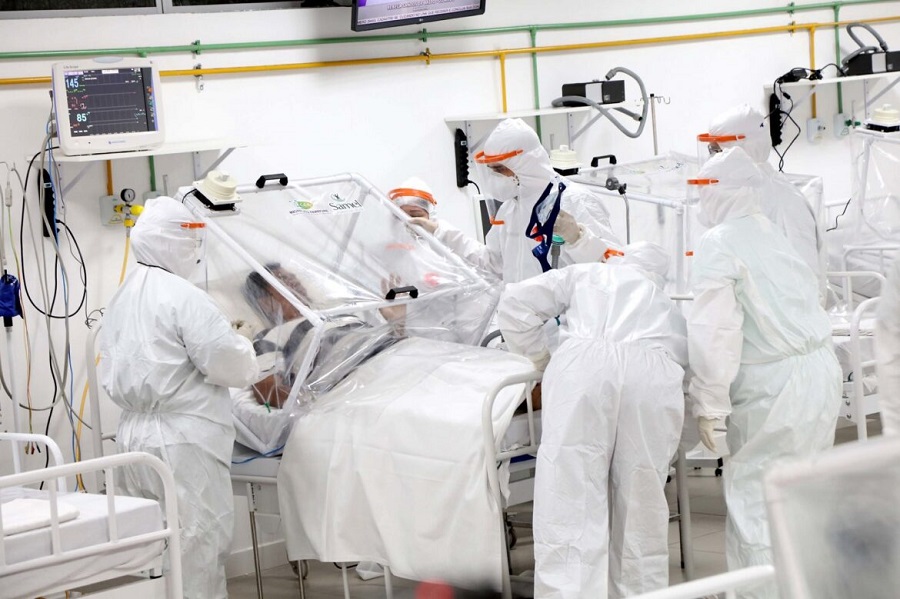RIO DE JANEIRO, BRAZIL – With the increase in admissions for Covid-19, private hospitals in São Paulo are again crowded and are planning adjustments so patients with other diseases will not be left unattended. There is no plan to suspend surgeries and elective procedures for the time being.
On Friday, May 28, the Albert Einstein Hospital was working with a 106% occupancy rate. This means that there were patients in the emergency room waiting for a bed. Hospitalizations include Covid-19 cases, other diseases, and surgical patients.

“Since the end of the year, we have not stopped. People are looking to have their deferred surgeries, which is good. We are working at the limit,” explains Sidney Klajner, Einstein’s president.
According to him, as a preventive measure, a tent will be set up next week in the hospital’s adjacent area to attend non-Covid patients of low complexity.
“Covid cases are increasing daily. The pressure on the demand for emergency rooms is back, hospitalizations in normal beds are increasing, but mainly in ICUs”, says Francisco Balestrin, president of Sindhosp (union of hospitals, clinics and laboratories in São Paulo).
On Friday, May 28, the Covid ICU at the Alemão Oswaldo Cruz Hospital stood at 99% occupancy. There were 141 patients admitted, 69 in the ICU. The hospital as a whole had an occupancy rate of 96%.
“If we compare the Covid-19 ICU occupancy rate of the first week of the month with the current week, May 28, the growth was 25%,” Oswaldo Cruz says in a statement. It also reinforces that new ICU and hospitalization beds can be opened according to demand.
Einstein has observed a continuous growth of Covid hospitalizations since May 14, when there were 114 patients hospitalized and 121 beds available for the disease.
As the number of cases increased, the number of beds rose to 172. Last Wednesday, May 26, and Thursday, May 27, the number of Covid inpatients totaled 168. On Friday, there were 164, of which 75 in intensive and semi-intensive care units.
“For the past 10 days, we have observed a linear increase, which is a reflection of people’s behavior,” says Klajner. At Einstein, the curve of increasing telemedicine consultations of patients with Covid symptoms has worked as a predictor of discharge from hospitalizations days later.
“This has allowed us to plan so that we don’t miss the non-Covid appointments. People can’t procrastinate any longer. Last week I operated on an urgent gallbladder. The patient delayed going to the hospital because she was waiting for the pandemic to improve. [Due to the aggravation], she had to stay a week in hospital because she had pancreatitis,” says Klajner.
The Sírio-Libanês Hospital registered 139 patients hospitalized by Covid at the beginning of this month, with an overall occupancy rate of 80%. On May 17, it increased to 141 inpatients and 75% occupancy. By Friday, it added 186 patients and an overall occupancy of 93%.
“Since last Friday, we have seen a consistent increase in hospitalizations. We can’t say that this is a third wave, but it is very worrying. The question is whether it is an oscillation or if it will continue to rise. Our concern is that it will continue to rise,” says Felipe Duarte, manager of medical practices at the Sírio.
He explains that the hospital will use the plans adopted in the last two waves of the pandemic to resize the spaces. “We can rearrange and adjust the structures to handle this surge from both sources, Covid and non-Covid cases.”
According to Duarte, the emergency room and the Covid diagnostic tests work as a gauge for the increase in hospitalizations that typically follow.
“Since last week we have observed a rise in new diagnoses and the volume of care in the PA, already a reflection of the relaxation of social measures that lead to more infections.”
The São Camilo hospital network is also registering a high number of Covid hospitalizations. On Friday, it had a 76% occupancy rate in wards and 67% in ICUs. On May 14, the respective rates stood at 60% and 50%.
“As the percentages vary constantly, the institution has been reallocating its internal beds daily to ensure that patients with other serious comorbidities are also attended to,” the hospital says in a statement.
With the older population now vaccinated, the age range of the most critical patients has dropped. A Sindhosp survey shows that today 18% of Covid ICU patients are aged between 35 and 59. In 2020, they accounted for 10%.
“Another factor is the exposure of the younger population, which has relaxed its distancing measures to a greater extent,” says Duarte.

